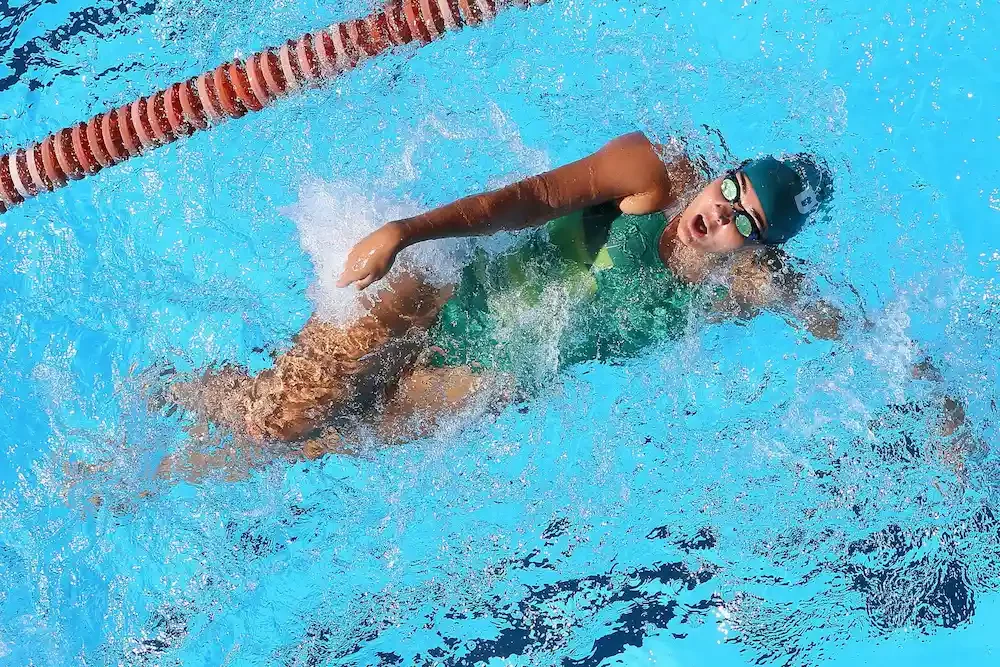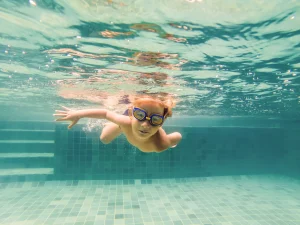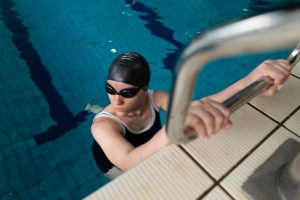Has your child started swimming and you find yourself lost with the terms and strokes and styles mentioned in lessons?
You need to understand the types of stroke and the sport’s characteristics to follow the lessons. It also helps you track your child’s progress and support their growth and development.
A 2018 University of Liverpool study found that parents’ confidence influences children’s behaviour during lessons, making them calmer, more curious, and more focused on activities.
So, keep a close eye on your child’s aquatic journey. Learn more about the four most practised strokes and the basic terminology of the sport.
What are the main swimming strokes and styles?
Although there are variations, there are four main strokes in swimming. A swimmer may specialise in one or practise all of them:
Front crawl (freestyle): the fastest and most popular
In swimming lessons, instructors most commonly teach front crawl. It features alternating arm movements, body rotation and continuous kicking. Another hallmark of this stroke is lateral breathing.
It’s the most suitable for beginners because it helps children build confidence and autonomy in the water.
In competitions, the “freestyle” event allows swimmers to choose any of the four strokes. Most choose front crawl because it’s the fastest—so swimmers often simply call it ‘freestyle’.
Backstroke: swimming on your back
Backstroke is the only stroke you swim on your back. Instructors often use it to develop motor coordination and strengthen back muscles.
The arm pulls alternate, similar to front crawl, but the face remains out of the water at all times, which aids breathing comfort—especially for beginners.
Because swimmers are on their backs and can’t see ahead, they count strokes or use reference points to stay on course. For this reason, lessons at home, in your own pool, are highly recommended to refine technique.
In a familiar environment, it’s easier for a child to develop orientation skills.

Breaststroke: demands coordination
Breaststroke is one of the most technical strokes and the most demanding in terms of coordination. The arms move in a semicircle in front of the body while the legs perform a frog-style kick.
The swimmer must coordinate these movements while regularly bringing the head above the water to breathe—meaning arms, legs and breathing need to be synchronised.
This stroke is slower than front crawl and backstroke, so it’s best approached with rhythm and patience.
Butterfly: power and synchrony in action
Butterfly is considered the most challenging stroke. It requires muscular strength—especially in the shoulders and core—plus strong breath control and coordination.
It uses simultaneous arm pulls combined with a wave-like movement of the body and two dolphin kicks.
Due to its complexity, butterfly is usually introduced only at more advanced stages of children’s swimming, once the other strokes are well established.
Even so, the fundamentals can be practised in playful, progressive ways. Private instructors can assess the swimmer and decide the right moment to advance techniques, respecting each child’s pace of development.
Common swimming terminology

Alongside the strokes and styles, it helps to know a few technical terms you may hear from teachers or during lessons:
- Tumble turn (also called a flip turn): a technique used in races to change direction quickly and efficiently;
- Block start: the initial dive from an elevated starting block used in competition;
- Bilateral breathing: breathing alternately to both sides, common in front crawl;
- Stroke technique: refining arm movements by adjusting force, range and efficiency;
- Coordination: the ability to synchronise arms, legs and breathing. Fundamental for every stroke;
- Glide: the initial phase of the swim when the body travels through the water after the push-off or the turn;
- Streamlined position: the most efficient body posture to reduce drag (body extended with the head aligned);
- Body roll: the lateral rotation that facilitates the arm stroke and breathing;
- Range of motion: how far the arms or legs move, generating greater propulsion.
How can parents get actively involved in swimming lessons?
By recognising the strokes and understanding the technical terms, parents can better follow their child’s progress, ask more relevant questions, and—most importantly—encourage children more thoughtfully.
Notice your child’s enthusiasm when they share what they’ve learnt and use the opportunity to reinforce each achievement positively.
Want to see your child progress with confidence, discipline and joy? Our instructors come to you with a personalised plan for each stage of development. Book a lesson with Easy2Swim and experience it at home.






